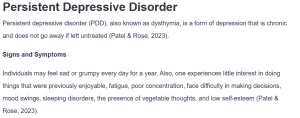Persistent Depressive Disorder
Persistent depressive disorder (PDD), also known as dysthymia, is a form of depression that is chronic and does not go away if left untreated (Patel & Rose, 2023).
Signs and Symptoms
Individuals may feel sad or grumpy every day for a year. Also, one experiences little interest in doing things that were previously enjoyable, fatigue, poor concentration, face difficulty in making decisions, mood swings, sleeping disorders, the presence of vegetable thoughts, and low self-esteem (Patel & Rose, 2023).
Treatment
On the plus side, there are measures that one may take to improve one’s condition—psychotherapy and pharmacological treatment (Nübel et al., 2020). In the therapy approach, a patient may be assisted by talking to a special friend who can enable them to reason with their emotions and be trained on how to tackle the situation. Examples include cognitive behavioral therapy (CBT), which aims to modify wrong thinking patterns and procedures, and interpersonal therapy (IPT), which focuses on an individual’s interactions with the environment.
Secondly, medication may be prescribed to enhance the level of chemicals in the brain related to mood. These may include selective serotonin reuptake inhibitors (SSRIs) like fluoxetine or sertraline and serotonin-norepinephrine reuptake inhibitors (SNRIs) like duloxetine (Nübel et al., 2020). Aside from the two treatment methods, exercise, having a healthy diet, getting enough sleep, socializing with friends and family, doing enjoyable activities, and the use of relaxation methods such as deep breathing or mindfulness could also be helpful.
Community Resources and Referrals
In cases where PDD is suspected in a child, family physician or pediatrician, school or education professionals, including counselors and psychologists, local community centers or mental health clinics, NAMI, and Child Mind Institute (Sharma et al., 2019) are the referrals for to seek help.
References
Nübel, J., Guhn, A., Müllender, S., Le, H. D., Cohrdes, C., & Köhler, S. (2020). Persistent depressive disorder across the adult lifespan: Results from clinical and population-based surveys in Germany. BMC Psychiatry, 20(1). https://doi.org/10.1186/s12888-020-2460-5
Patel, R. K., & Rose, G. M. (2023, June 26). Persistent depressive disorder (Dysthymia). PubMed; StatPearls Publishing. https://www.ncbi.nlm.nih.gov/books/NBK541052/
Sharma, E., Srinath, S., Jacob, P., & Gautam, A. (2019). Clinical practice guidelines for assessment of children and adolescents. Indian Journal of Psychiatry, 61(8), 158–175. https://doi.org/10.4103/psychiatry.indianjpsychiatry_580_18
ORDER A PLAGIARISM-FREE PAPER HERE
We’ll write everything from scratch
Question
Patient education is an effective tool in supporting compliance and treatment for a diagnosis. It is important to consider effective ways to educate patients and their families about a diagnosis, such as coaching, brochures, or videos, and to recognize that the efficacy of any materials may differ based on the needs and learning preferences of a particular patient. Because patients or their families may be overwhelmed with a new diagnosis, it is important that materials provided by the practitioner clearly outline the information that patients need to know.
For this Assignment, you will pretend that you are a contributing writer to a health blog. You are tasked with explaining important information about an assigned mental health disorder in language appropriate for child/adolescent patients and/or their caregivers. (Disorder: Persistent Depressive Disorder)

Persistent Depressive Disorder
To Prepare :
- By Day 1, your Instructor will assign a mood or anxiety disorder diagnosis for you to use for this Assignment. (Disorder: Persistent Depressive Disorder)
- Research signs and symptoms for your diagnosis, pharmacological treatments, nonpharmacological treatments, and appropriate community resources and referrals.
The Assignment –
- In a one page post written for a patient and/or caregiver audience, explain signs and symptoms for your diagnosis, pharmacological treatments, nonpharmacological treatments, and appropriate community resources and referrals.
Resources:
- Sadock, B. J., Sadock, V. A., & Ruiz, P. (2015). Kaplan & Sadock’s synopsis of psychiatry (11th ed.). WoltersKluwer.
- Zakhari, R. (2020). The psychiatric-mental health nurse practitioner certification review manual. Springer.

